Embarking on a journey to enhance your hydrangeas in landscaping isn’t just about the blooms themselves—it’s also about the perfect companions. Understanding what to plant with hydrangeas can transform a garden into a symphony of color, texture, and harmony. Whether your garden basks in full sun, enjoys dappled shade, or revels in the cool embrace of full shade, there’s a perfect combination of flora waiting to elevate your hydrangeas to new heights.
In this comprehensive guide, we delve into the importance of choosing the best companion plants tailored to each light requirement, from ground covers to ornamental grasses. Not only will you learn which plants complement your hydrangeas’ beauty, but you will also discover those you should keep at bay. With insights into care tips and an easy-to-reference table summarizing ideal plant pairings, you’ll be equipped to craft a captivating landscape that’s as vibrant as it is harmonious. Let’s embark on a journey to unlock the secrets of creating the perfect hydrangea paradise.
Table of Contents
Hydrangeas in Landscaping: Top Companion Plants
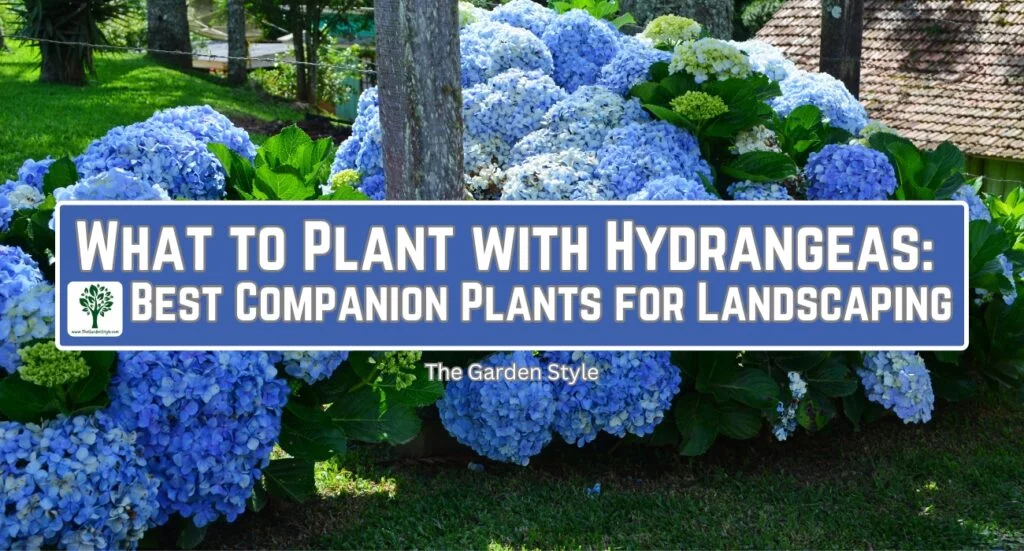
Whether you’re cultivating under the radiant beams of full sun or the dappled shades of partial to full shade, we’ve got you covered. Discover the perfect foliage companions for hydrangeas, from vibrant blooms to lush ground covers and elegant ornamental grasses. Explore the harmonious interplay of color, texture, and form as we unlock the secrets to successful landscaping with hydrangeas.
If you are starting cut flower garden, Hydrangeas are a great choice as a cut flower for flower arrangements.
What to Plant with Hydrangeas for Full to Partial Sun
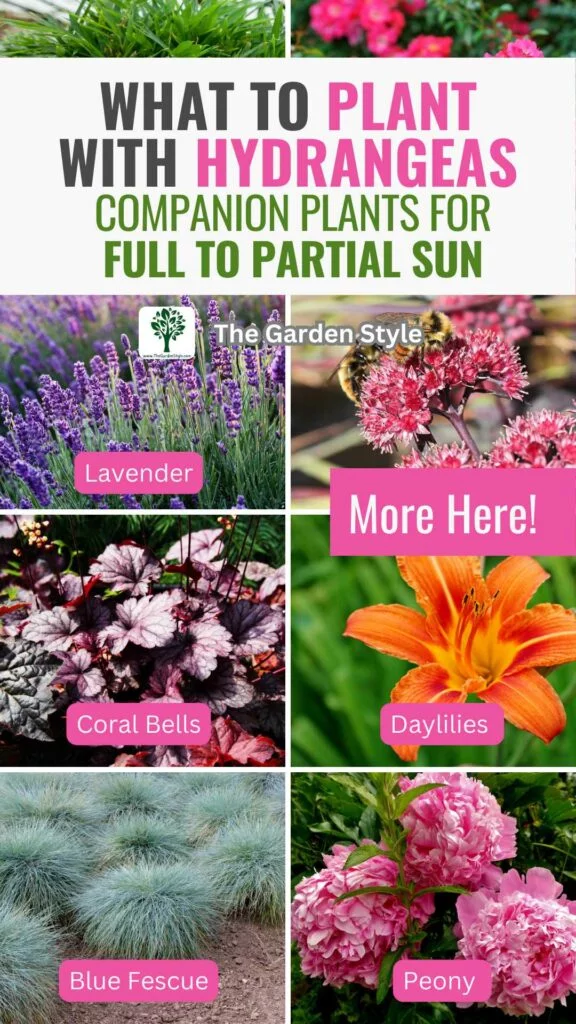
Many Hydrangeas varieties thrive in a sunny garden spot, even some potted Hydrangeas. Let’s see what to plant with Hydrangeas in full and partial sun locations.
Blue Fescue (Festuca glauca)

Blue Fescue, a low-growing ornamental grass with slender blue-gray foliage, is an excellent companion plant for hydrangeas, adding a cool hue to garden borders and containers. Take a look at these stunning Blue Fescue for your garden.
- Suggested USDA Hardiness Zones: 4-8
- Size: 8-12 inches (20-30 cm) tall and wide
- Care requirements: Prefers full sun to partial shade and well-drained soil.
- Attract: Not a significant attractor for pollinators.
Coral Bells (Heuchera)

Coral Bells are prized for their vibrant foliage in shades of green, purple, and bronze. Their mounded growth habit complements hydrangeas. Take a look at these stunning Coral Bells for your garden.
- Suggested USDA Hardiness Zones: 4-9
- Size: 6-18 inches (15-45 cm) tall and wide, depending on the variety
- Care requirements: Thrives in partial shade and moist, well-drained soil.
- Attract: Can attract hummingbirds with their delicate flowers.
Daylilies (Hemerocallis)
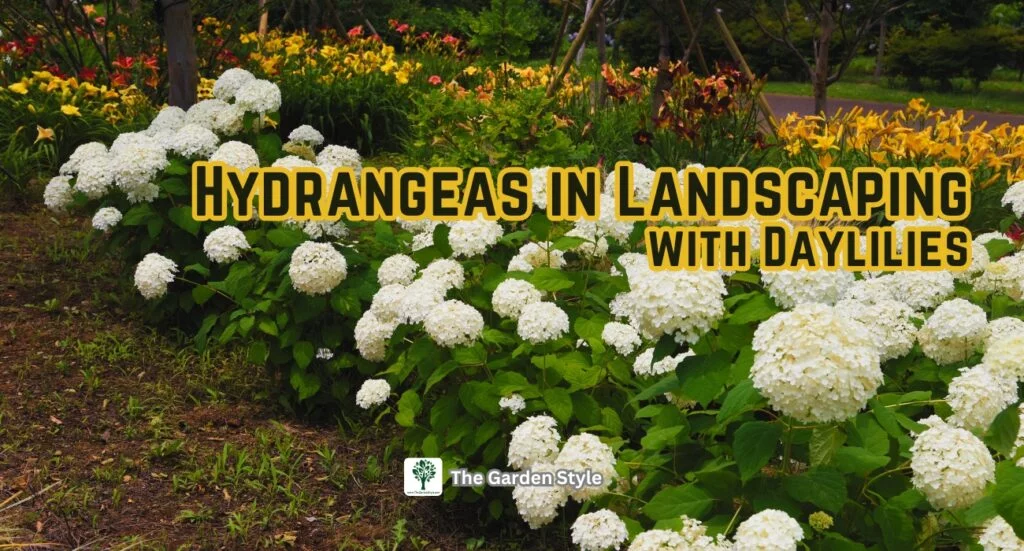
Daylilies offer a profusion of trumpet-shaped blooms in various colors, adding a burst of color to hydrangea beds during their blooming season.
- Suggested USDA Hardiness Zones: 3-9
- Size: 12-36 inches (30-90 cm) tall and 12-24 inches (30-60 cm) wide
- Care requirements: Prefers full sun to partial shade and well-drained soil.
- Expected Blooming: Spring to summer
- Attract: Attracts butterflies and hummingbirds.
Japanese Forest Grass (Hakonechloa macra)

Japanese Forest Grass, forming cascading mounds of arching foliage, is an ideal companion plant for hydrangeas. It provides a graceful contrast to the bold blooms. Take a look at these stunning Japanese Forest Grass for your garden.
- Suggested USDA Hardiness Zones: 5-9
- Size: 12-18 inches (30-45 cm) tall and wide
- Care requirements: Thrives in partial shade and moist, well-drained soil.
- Attract: Not a significant attractor for pollinators.
Lavender (Lavandula)
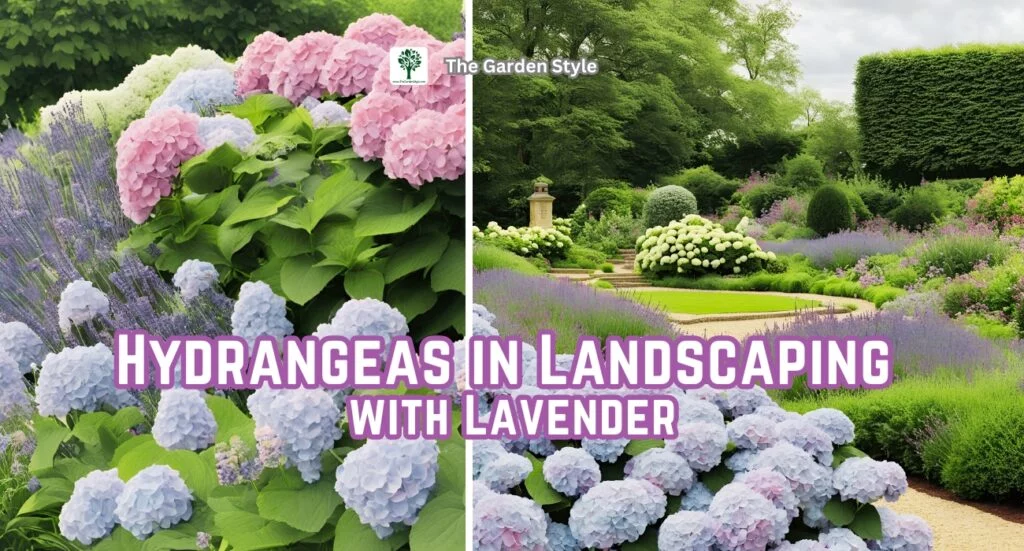
Lavender is prized for its fragrant spikes of purple-blue flowers and silvery-green foliage, adding a sensory experience to the garden.
- Suggested USDA Hardiness Zones: 5-9
- Size: 12-24 inches (30-60 cm) tall and wide
- Care requirements: Requires full sun and well-drained slightly alkaline soil.
- Expected Blooming: Summer
- Attract: Attracts bees and butterflies.
Recommended reading: How to Propagate Lavender: A Step-by-Step Guide
Peony (Paeonia)

Peonies are renowned for their large, showy blooms in an array of colors, creating a stunning focal point alongside hydrangeas. Take a look at these stunning Kansas Peony for your garden.
- Suggested USDA Hardiness Zones: 3-8
- Size: 24-36 inches (60-90 cm) tall and wide
- Care requirements: Prefers full sun to partial shade and fertile, well-drained soil.
- Expected Blooming: Late spring to early summer
- Attract: Attracts bees and butterflies.
Recommended reading: Golly Flower Care and Propagation
Sedum (Stonecrop)

Sedum features succulent foliage and clusters of star-shaped flowers, providing textural interest and drought tolerance to garden beds.
- Suggested USDA Hardiness Zones: 3-9
- Size: 6-24 inches (15-60 cm) tall and 12-24 inches (30-60 cm) wide, depending on the variety
- Care requirements: Thrives in full sun and well-drained soil.
- Attract: Attracts bees and butterflies.
Shrub Roses

Shrub Roses, offering a diverse range of colors and forms, make an excellent companion plant for hydrangeas. They provide a classic and romantic addition to hydrangea landscapes. Take a look at these stunning shrub Roses for your garden.
- Suggested USDA Hardiness Zones: 4-9
- Size: Varies widely depending on the variety, ranging from compact to sprawling.
- Care requirements: Most varieties prefer full sun and well-drained soil.
- Expected Blooming: Spring to fall, depending on the variety
- Attract: Attracts bees and butterflies.
Recommended reading: How to Care Knockout Roses
What to Plant with Hydrangeas for Partial to Full Shade
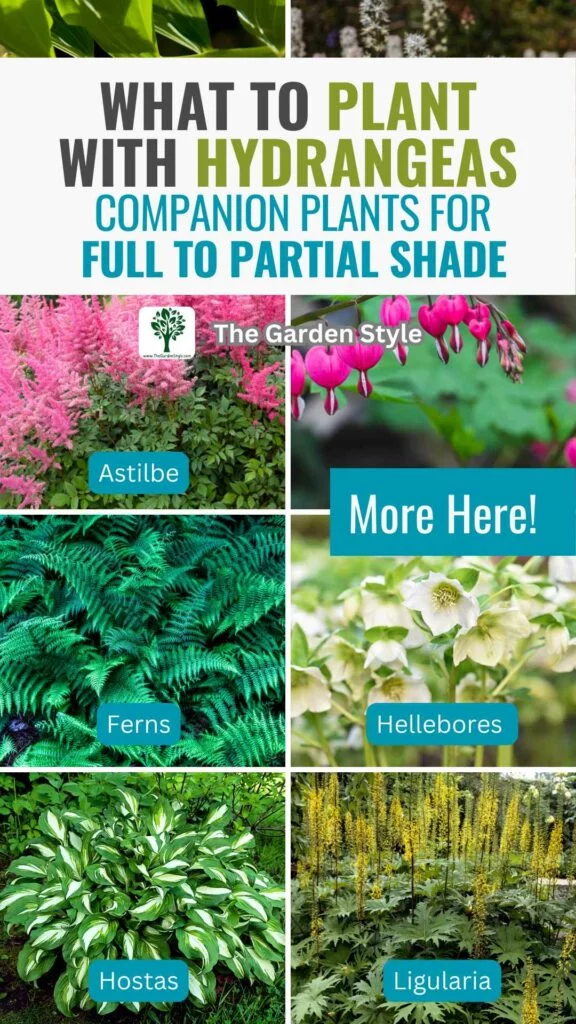
There are many annual and perennial flowers and foliage plants that thrive in a shade garden. Let’s explore what to plant with hydrangeas in a shady spot.
Astilbe

Astilbe produces feathery plumes of flowers in shades of white, pink, red, and purple, adding color and vertical interest to shade gardens.
- Suggested USDA Hardiness Zones: 4-9
- Size: 1-4 feet (30-120 cm) tall and 1-3 feet (30-90 cm) wide, depending on the variety
- Care requirements: Thrives in partial to full shade and moist, well-drained soil.
- Expected Blooming: Late spring to early summer
- Attract: Attracts bees and butterflies.
Bleeding Hearts (Dicentra)

Bleeding Hearts are beloved for their heart-shaped flowers dangling from arching stems, adding a romantic and whimsical touch to shade gardens.
- Suggested USDA Hardiness Zones: 3-9
- Size: 12-24 inches (30-60 cm) tall and wide
- Care requirements: Prefer partial to full shade and moist, well-drained soil.
- Expected Blooming: Spring to early summer
- Attract: Not significant attractors for pollinators.
Ferns
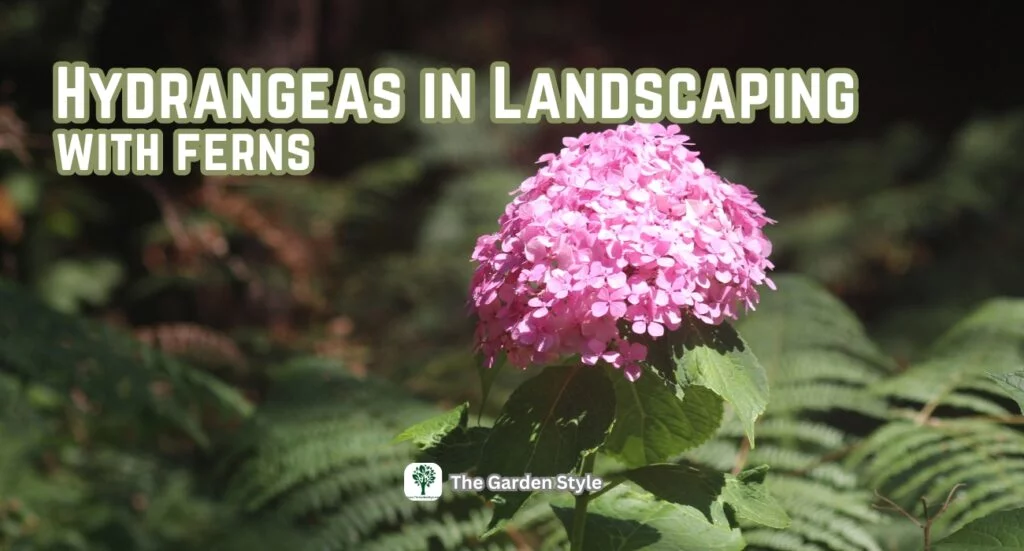
Ferns, with delicate fronds and a variety of shapes and sizes, make excellent companion plants for hydrangeas. They provide a graceful backdrop or ground cover in shady areas.
- Suggested USDA Hardiness Zones: Varies depending on the species; many are hardy in zones 3-8
- Size: Varies widely depending on the species, from a few inches to several feet tall and wide
- Care requirements: Prefer partial to full shade and moist, well-drained soil.
- Attract: Not significant attractors for pollinators.
Recommened reading: How to Propagate Ferns
Hellebores (Lenten Rose)

Hellebores produce nodding flowers in shades of white, pink, purple, and green. They bloom early in the year and provide color when the garden awakens. Take a look at these stunning Hellebores for your garden.
- Suggested USDA Hardiness Zones: 4-9
- Size: 12-24 inches (30-60 cm) tall and wide
- Care requirements: Thrive in partial to full shade and moist, well-drained soil.
- Expected Blooming: Late winter to early spring
- Attract: Attracts bees and butterflies.
Hostas
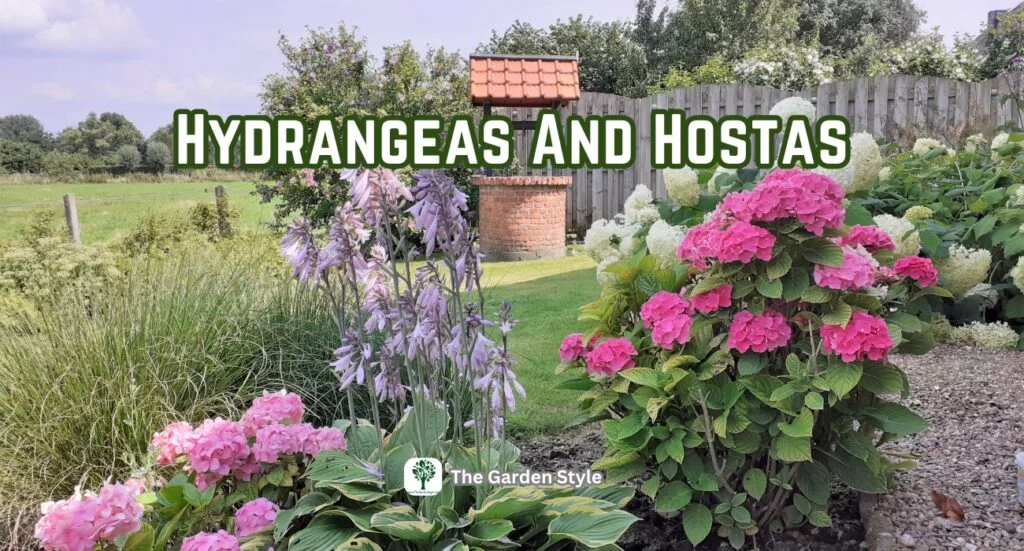
Hostas are known for their lush foliage in various shades of green, blue, and variegated patterns, adding texture and interest to shade gardens.
- Suggested USDA Hardiness Zones: 3-9
- Size: 6 inches to 3 feet (15-90 cm) tall and wide, depending on the variety
- Care requirements: Thrive in partial to full shade and moist, well-drained soil.
- Attract: Not significant attractors for pollinators.
Recommended reading: How to Grow Hostas
Ligularia

Ligularia features bold, kidney-shaped leaves and tall spikes of yellow, orange, or red-orange flowers, adding drama and color contrast to shaded gardens.
- Suggested USDA Hardiness Zones: 4-8
- Size: 2-4 feet (60-120 cm) tall and wide, depending on the variety
- Care requirements: Prefers partial to full shade and consistently moist, well-drained soil.
- Attract: Attracts bees and butterflies.
Solomon’s Seal (Polygonatum)

Solomon’s Seal features arching stems adorned with dangling, bell-shaped flowers and attractive, alternate leaves, adding elegance to shady spots.
- Suggested USDA Hardiness Zones: 3-9
- Size: 1-4 feet (30-120 cm) tall and 1-3 feet (30-90 cm) wide, depending on the variety
- Care requirements: Prefers partial to full shade and moist, well-drained soil.
- Attract: Not significant attractors for pollinators.
Tiarella (Foamflower)

Tiarella, producing delicate, foam-like clusters of white or pink flowers above attractive foliage, is a wonderful companion plant for hydrangeas, creating a carpet of color in woodland gardens. Take a look at these stunning Tiarella for your garden.
- Suggested USDA Hardiness Zones: 4-9
- Size: 6-12 inches (15-30 cm) tall and 12-18 inches (30-45 cm) wide
- Care requirements: Thrives in partial to full shade and moist, well-drained soil.
- Expected Blooming: Spring to early summer
- Attract: Attracts bees and butterflies.
Landscaping with Hydrangeas and Ground Cover Options
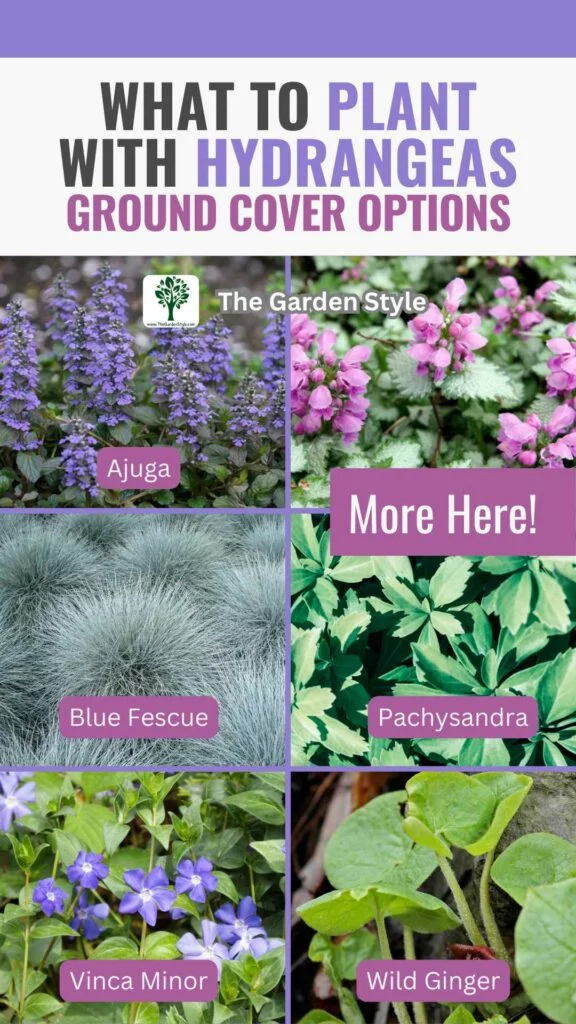
Ajuga (Bugleweed)

Ajuga forms dense mats of colorful foliage and spikes of blue, purple, or white flowers, providing both beauty and weed suppression.
- Suggested USDA Hardiness Zones: 3-10
- Size: 3-6 inches (7-15 cm) tall and spreading up to 12 inches (30 cm) wide
- Care requirements: Prefers partial to full shade and well-drained soil.
- Attract: Attracts bees and butterflies.
Blue Fescue (Festuca glauca)

Blue Fescue is a low-growing ornamental grass with slender blue-gray foliage, creating a soft and textured carpet beneath hydrangeas. Take a look at these stunning Blue Fescue for your garden.
- Suggested USDA Hardiness Zones: 4-8
- Size: 8-12 inches (20-30 cm) tall and wide
- Care requirements: Prefers full sun to partial shade and well-drained soil.
- Attract: Not a significant attractor for pollinators.
Lamium (Dead Nettle)

Lamium, featuring variegated foliage and clusters of small, tubular flowers, is an excellent companion plant for hydrangeas, providing colorful ground cover in shady areas.
- Suggested USDA Hardiness Zones: 4-8
- Size: 4-12 inches (10-30 cm) tall and spreading up to 24 inches (60 cm) wide
- Care requirements: Thrives in partial to full shade and moist, well-drained soil.
- Attract: Attracts bees and butterflies.
Pachysandra

Pachysandra forms dense evergreen mats of glossy foliage, serving as a reliable and low-maintenance ground cover beneath hydrangeas.
- Suggested USDA Hardiness Zones: 4-9
- Size: 6-12 inches (15-30 cm) tall and spreading up to 24 inches (60 cm) wide
- Care requirements: Prefers partial to full shade and moist, well-drained soil.
- Attract: Not significant attractors for pollinators.
Vinca Minor (Lesser Periwinkle)

Vinca Minor features trailing stems, glossy green foliage, and blue-purple flowers, making it a charming and resilient ground cover option.
- Suggested USDA Hardiness Zones: 4-9
- Size: 3-6 inches (7-15 cm) tall and spreading indefinitely
- Care requirements: Thrives in partial to full shade and well-drained soil.
- Attract: Not significant attractors for pollinators.
Recommended reading: How To Care for Vinca Flowers
Wild Ginger (Asarum)

Wild Ginger boasts heart-shaped foliage and inconspicuous, yet intriguing, flowers, creating a lush ground cover in shaded areas.
- Suggested USDA Hardiness Zones: 4-9
- Size: 6-12 inches (15-30 cm) tall and spreading up to 18 inches (45 cm) wide
- Care requirements: Prefers partial to full shade and moist, well-drained soil.
- Attract: Not significant attractors for pollinators.
Landscaping with Hydrangeas and Ornamental Grasses
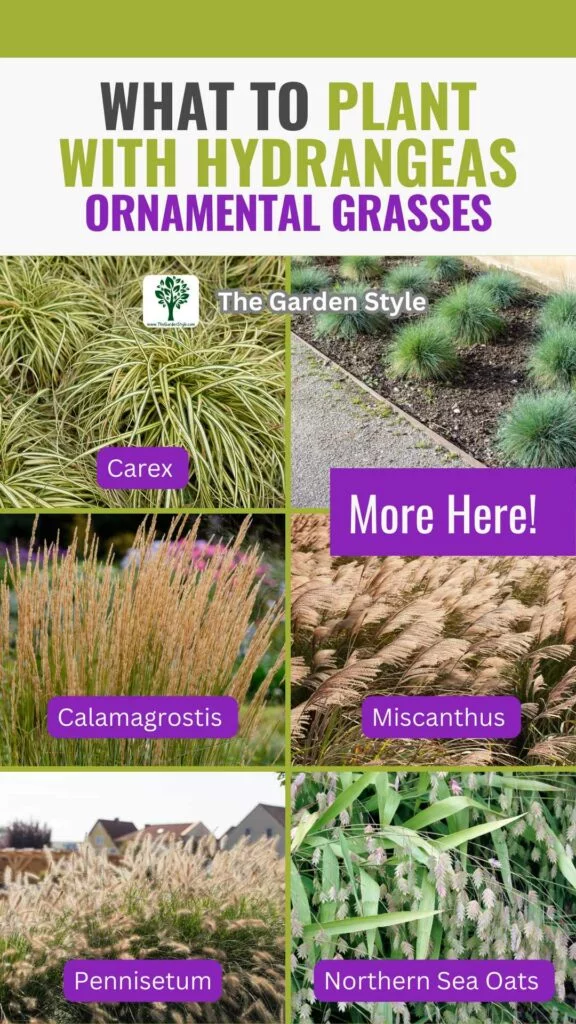
Blue Fescue (Festuca glauca)

Blue Fescue is a low-growing ornamental grass with slender blue-gray foliage, providing a cool contrast to the lush blooms of hydrangeas.
- Suggested USDA Hardiness Zones: 4-8
- Size: 8-12 inches (20-30 cm) tall and wide
- Care requirements: Prefers full sun to partial shade and well-drained soil.
- Attract: Not significant attractors for pollinators.
Calamagrostis (Feather Reed Grass)

Calamagrostis, forming upright clumps of narrow foliage topped with feathery flower spikes, is a great companion plant for hydrangeas, adding vertical interest and movement to hydrangea plantings. Take a look at these stunning Calamagrostis for your garden.
- Suggested USDA Hardiness Zones: 4-9
- Size: 2-4 feet (60-120 cm) tall and 1-2 feet (30-60 cm) wide
- Care requirements: Prefers full sun to partial shade and moist, well-drained soil.
- Attract: Not significant attractors for pollinators.
Carex (Sedge)

Carex encompasses a diverse group of grass-like plants with various colors and textures, offering versatility and interest as ground covers or accents.
- Suggested USDA Hardiness Zones: Varies depending on the species; many are hardy in zones 4-9
- Size: Varies widely depending on the species and cultivar
- Care requirements: Most prefer partial to full shade and consistently moist soil.
- Attract: Not significant attractors for pollinators.
Fountain Grass (Pennisetum)
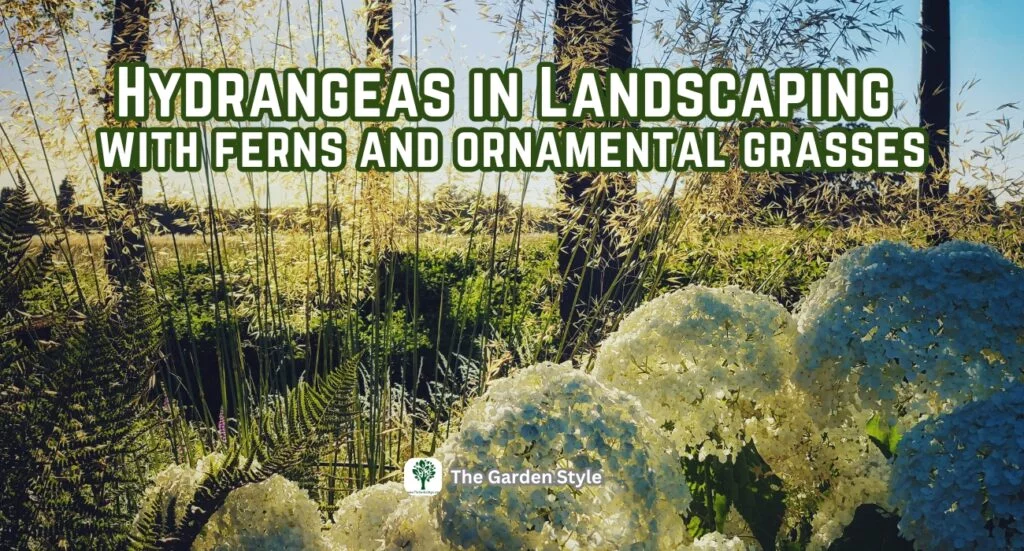
Fountain Grass produces graceful arching foliage and feathery plumes, creating a soft and elegant backdrop for hydrangeas in garden borders. Take a look at these stunning Fountain Grass for your garden.
- Suggested USDA Hardiness Zones: 5-9
- Size: 2-4 feet (60-120 cm) tall and wide, depending on the variety
- Care requirements: Prefers full sun and well-drained soil.
- Attract: Attracts birds with its seeds.
Miscanthus (Maiden Grass)

Miscanthus forms large clumps of tall, arching foliage and dramatic plumes of flowers, adding height and drama to hydrangea landscapes.
- Suggested USDA Hardiness Zones: 5-9
- Size: 4-8 feet (120-240 cm) tall and 3-6 feet (90-180 cm) wide, depending on the variety
- Care requirements: Prefers full sun to partial shade and well-drained soil.
- Attract: Not significant attractors for pollinators.
Northern Sea Oats (Chasmanthium latifolium)

Northern Sea Oats, featuring bamboo-like foliage and dangling seed heads, is an excellent companion plant for hydrangeas. It adds texture and movement to shaded areas alongside the hydrangeas.
- Suggested USDA Hardiness Zones: 3-8
- Size: 2-4 feet (60-120 cm) tall and 1-2 feet (30-60 cm) wide
- Care requirements: Thrives in partial to full shade and moist, well-drained soil.
- Attract: Attracts birds with its seeds.
At a Glance: The Best Companion Plants for Hydrangeas
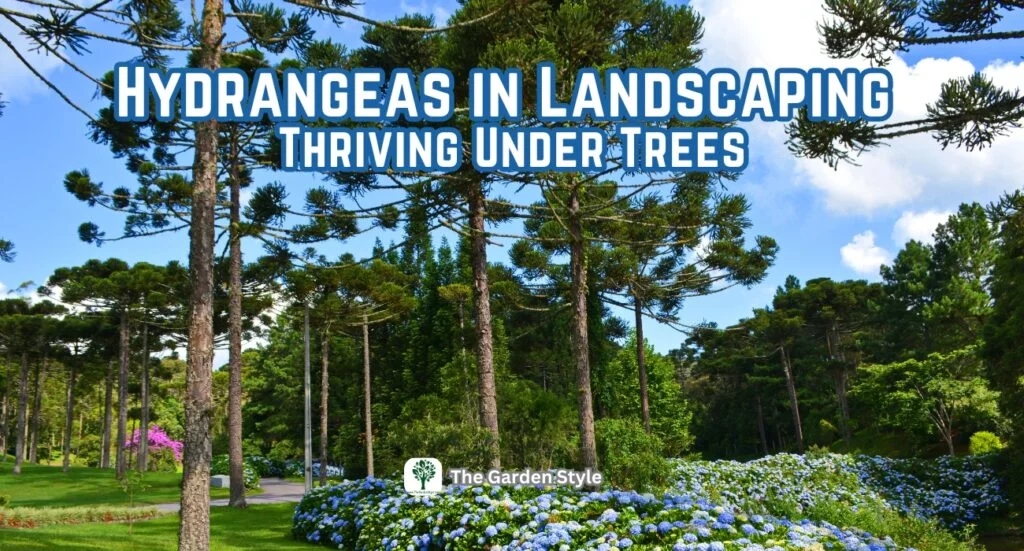
Below is a chart with a summary of the best companion plants for hydrangeas discussed in this article. Let’s look at care tips, blooming times, and pollinator attractors.
| Name | Sunlight Preference | Watering Needs | Other Care Tips | Blooming Time | Attract |
| Ajuga (Bugleweed) | Partial to full shade | Moist, well-drained | Trim back after flowering to maintain tidy appearance | Spring to early summer | Bees and butterflies |
| Astilbe | Partial to full shade | Moist | Mulch to retain moisture and suppress weeds | Late spring to summer | Bees and butterflies |
| Bleeding Hearts | Partial to full shade | Moist | Provide shelter from strong winds | Spring to early summer | Not significant |
| Blue Fescue | Full sun to partial shade | Moderate | Requires good drainage | Not applicable | Not significant |
| Calamagrostis | Full sun to partial shade | Moderate | Cut back in late winter before new growth appears | Summer to fall | Not significant |
| Carex (Sedge) | Partial to full shade | Moist | Mulch in winter for cold protection | Varies depending on species | Not significant |
| Coral Bells | Partial to full shade | Moist, well-drained | Divide clumps every 3-4 years to rejuvenate | Spring to summer | Can attract hummingbirds |
| Daylilies | Full sun to partial shade | Moderate | Deadhead spent flowers to promote reblooming | Spring to summer | Attracts butterflies |
| Ferns | Partial to full shade | Moist | Provide consistent moisture and avoid direct sun exposure | Not applicable | Not significant |
| Fountain Grass | Full sun | Moderate | Cut back in late winter before new growth appears | Summer to fall | Birds with seeds |
| Hellebores | Partial to full shade | Moist, well-drained | Remove old leaves to prevent fungal diseases | Late winter to spring | Attracts bees and butterflies |
| Hostas | Partial to full shade | Moist, well-drained | Protect from slugs and snails | Not applicable | Not significant |
| Japanese Forest Grass | Partial to full shade | Moist | Mulch to retain moisture and suppress weeds | Not applicable | Not significant |
| Lamium (Dead Nettle) | Partial to full shade | Moist | Can be invasive, consider containment methods | Spring to summer | Bees and butterflies |
| Lavender | Full sun | Low | Prune after flowering to maintain shape | Summer | Bees and butterflies |
| Ligularia | Partial to full shade | Moist | Provide shelter from strong winds | Summer to fall | Attracts bees and butterflies |
| Miscanthus (Maiden Grass) | Full sun to partial shade | Moderate | Cut back in late winter before new growth appears | Summer to fall | Not significant |
| Northern Sea Oats | Partial to full shade | Moist | Can be aggressive spreaders, consider containment methods | Summer to fall | Birds with seeds |
| Pachysandra | Partial to full shade | Moist | Spreads by rhizomes, control spread if desired | Not applicable | Not significant |
| Peony | Full sun to partial shade | Moderate | Provide support for heavy blooms to prevent flopping | Late spring to early summer | Attracts bees and butterflies |
| Sedum (Stonecrop) | Full sun | Low | Avoid overwatering, as it can lead to root rot | Summer to fall | Attracts bees and butterflies |
| Solomon’s Seal | Partial to full shade | Moist | Protect from slugs and snails | Spring to early summer | Not significant |
| Tiarella (Foamflower) | Partial to full shade | Moist | Divide clumps every 2-3 years to maintain vigor | Spring to early summer | Attracts bees and butterflies |
| Vinca Minor | Partial to full shade | Moist | Considered invasive in some areas, monitor and contain | Spring to early summer | Not significant |
| Wild Ginger | Partial to full shade | Moist | Control weeds and provide consistent moisture | Not applicable | Not significan |
What Plants to Keep Away from Hydrangeas
Hydrangeas are beautiful flowering shrubs, and while they’re generally low-maintenance, there are some plants you might want to avoid planting alongside them due to differences in soil requirements, moisture needs, or growth habits. Here are a few examples:
- Evergreen Shrubs: Hydrangeas prefer well-draining soil, while many evergreen shrubs, such as rhododendrons and azaleas, prefer acidic soil with good moisture retention. Planting them together might result in competition for nutrients and water.
- Aggressive Spreaders: Plants with aggressive spreading habits, like certain groundcovers or invasive species, can overwhelm hydrangeas and compete for resources.
- Tall or Dense Plants: Avoid planting tall or dense plants too close to hydrangeas. These plants may block sunlight or air circulation, which can affect the health and growth of the hydrangeas.
- Plants with Different Watering Needs: Hydrangeas prefer consistently moist soil, so avoid planting them near plants with very different watering needs. For example, drought-tolerant plants may not appreciate the frequent watering that hydrangeas require.
- Plants that Prefer Different Soil pH: Some plants prefer acidic soil, while others prefer alkaline soil. Hydrangeas can tolerate a range of soil pH, but planting them alongside plants with very different pH preferences might result in one species not thriving.
Ultimately, it’s important to consider the specific growing conditions and needs of both the hydrangeas and the plants you want to plant alongside them.
Recommended reading: Common Hydrangea Problems Guide

